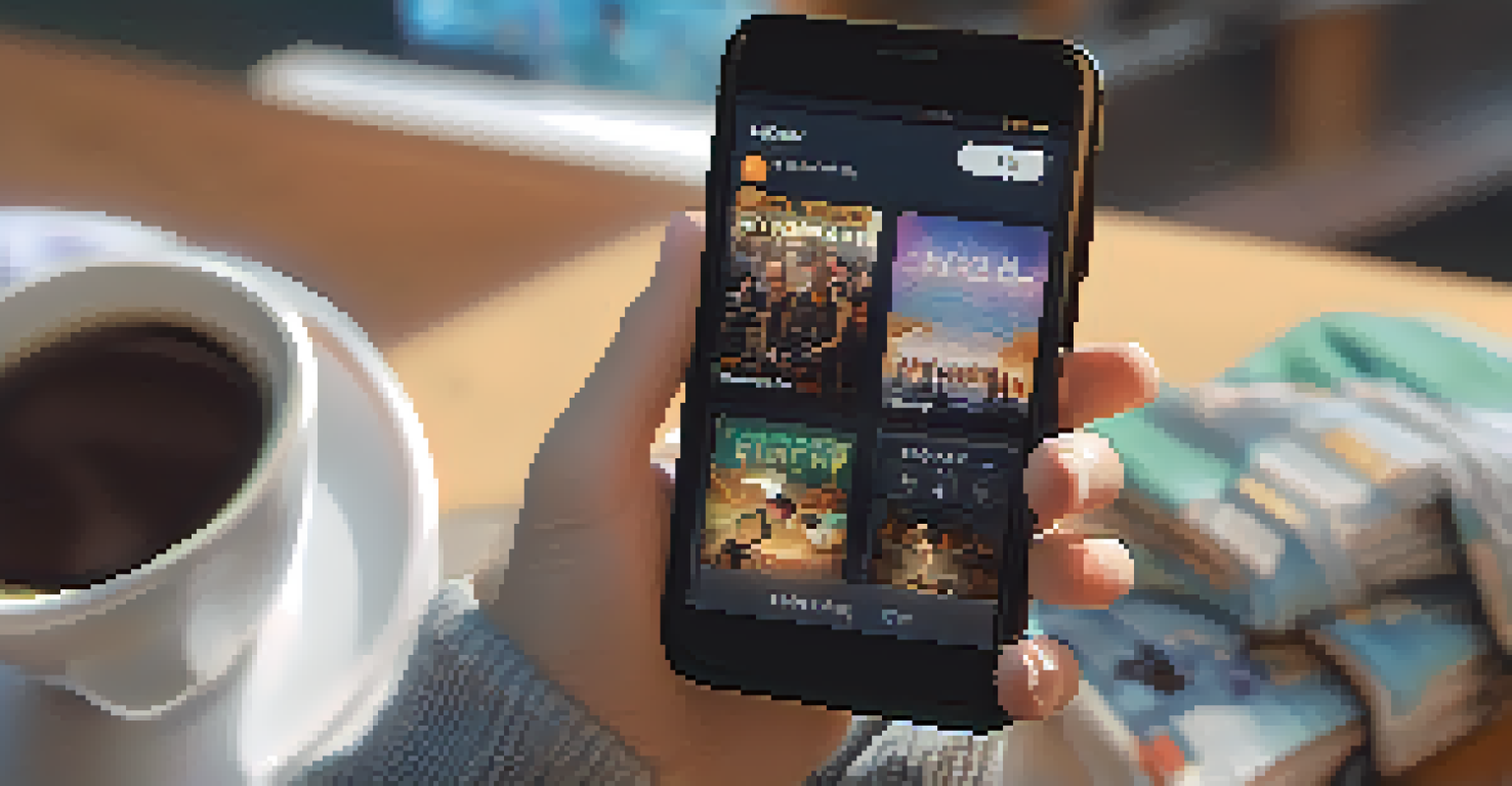The Rise of Streaming Services and Its Impact on Cinematic Styles

The Emergence of Streaming Services in the Entertainment Landscape
Streaming services like Netflix, Hulu, and Amazon Prime have drastically changed how we consume media. Gone are the days of waiting for a weekly episode; now, entire seasons are just a click away. This shift has not only altered viewing habits but has also created a competitive landscape for content creators.
The future of storytelling lies in the hands of the audience, and streaming services are giving them the power to shape their own experiences.
With the rise of on-demand viewing, audiences can curate their own experiences, watching what they want when they want. This flexibility has led to a surge in binge-watching culture, where viewers devour multiple episodes in one sitting. As a result, storytelling has evolved to accommodate this new way of consuming content.
The streaming model has also democratized access to diverse content, allowing independent filmmakers to reach larger audiences. This has paved the way for innovative storytelling techniques and fresh cinematic styles, as creators are no longer confined to traditional distribution methods.
Changing Cinematic Styles: From Theatrical to Digital
As streaming services gain popularity, the distinction between film and television continues to blur. Many high-quality productions, once reserved for cinemas, are now being created specifically for streaming platforms. This has encouraged filmmakers to experiment with formats, pacing, and visual styles that differ from traditional cinema.

For instance, the rise of limited series allows for deeper character development and more complex narratives. Unlike a standard two-hour film, these series can delve into subplots and character arcs over several episodes, providing a richer experience for viewers. This shift has prompted filmmakers to think more like novelists, crafting multi-layered stories.
Streaming Transforms Media Consumption
Streaming services have revolutionized how we consume content, enabling binge-watching and on-demand viewing.
Moreover, streaming platforms often have the freedom to explore unconventional themes and genres that might not thrive in a theatrical environment. This creative latitude has led to more diverse and inclusive storytelling, reflecting a wider array of human experiences and perspectives.
The Impact of Algorithm-Driven Content Recommendations
One of the defining features of streaming services is their use of algorithms to recommend content to viewers. These algorithms analyze user behavior to suggest films and shows, often leading to a more personalized viewing experience. However, this can also create echo chambers, where audiences are fed similar types of content.
In this era of streaming, diversity isn't just a trend; it's a necessity for authentic storytelling that resonates with viewers around the world.
This algorithm-driven model can influence what gets made, as studios may prioritize projects that align with trending viewer preferences. While this can be beneficial for creators whose work fits these patterns, it might stifle innovation by discouraging risk-taking on unconventional projects. As a result, filmmakers may find themselves navigating the fine line between creative freedom and commercial viability.
Additionally, the emphasis on data can lead to formulaic storytelling, where certain tropes and themes are recycled to meet audience expectations. This trend raises important questions about the future of creativity in an era dominated by data analytics and viewer metrics.
Diverse Perspectives: Inclusion and Representation in Streaming
Streaming services have made significant strides in promoting diversity and representation in film and television. With global reach, platforms like Netflix have the ability to showcase stories from different cultures and communities that traditional media often overlook. This shift has opened doors for underrepresented voices in the industry.
For example, shows like 'Money Heist' and 'Squid Game' have gained international acclaim, proving that audiences are hungry for authentic stories from different parts of the world. This not only enriches the viewing experience but also encourages cross-cultural dialogue and understanding among diverse audiences.
Diversity in Storytelling is Growing
Platforms like Netflix are amplifying underrepresented voices and showcasing diverse narratives from around the world.
However, as streaming platforms continue to champion inclusivity, there remains a challenge in ensuring that these narratives are told authentically. It is crucial for creators to engage with the communities they aim to represent, fostering genuine storytelling that resonates with viewers.
The Role of Original Content in Streaming Success
Original content has become a cornerstone of streaming services' strategies, with platforms investing heavily in creating exclusive films and series. This approach not only attracts subscribers but also helps build brand identity. Shows like 'Stranger Things' and 'The Crown' have become cultural phenomena, demonstrating the potential for original programming to create dedicated fan bases.
Furthermore, the competition for original content has sparked a creative renaissance in the industry, pushing filmmakers and writers to innovate. With the race to produce captivating stories, we are witnessing a surge in high-quality productions that challenge conventional narratives and push artistic boundaries.
However, as the demand for original content increases, the pressure on creators can also lead to burnout. It’s essential for the industry to balance quantity with quality, ensuring that creativity is not sacrificed in the pursuit of producing more content.
Changing Audience Engagement: Interactive Viewing Experiences
Streaming services are not just changing what we watch; they are also transforming how we engage with content. Interactive shows, like 'Black Mirror: Bandersnatch,' allow viewers to make choices that alter the narrative, creating a unique viewing experience. This innovation invites audiences to become active participants in storytelling, rather than passive observers.
Such interactive formats challenge traditional storytelling conventions and encourage filmmakers to rethink plot structures and character development. This can lead to more immersive narratives, where the choices viewers make influence the outcome of the story, ultimately deepening their connection to the content.
Original Content Drives Success
The focus on original programming has led to a creative renaissance in the industry, resulting in high-quality productions.
However, the success of interactive content hinges on balancing engagement with coherence. As creators navigate this new frontier, they must ensure that the choices presented to viewers enhance rather than detract from the overall narrative quality.
The Future of Cinematic Styles in a Streaming-Driven World
As streaming services continue to dominate the entertainment landscape, the future of cinematic styles is poised for further evolution. Filmmakers are increasingly experimenting with hybrid formats, blending elements of film and television to create unique viewing experiences. This trend reflects a growing willingness to break traditional molds and explore new storytelling possibilities.
Moreover, as technology advances, we may see the integration of augmented reality (AR) and virtual reality (VR) into streaming content. These innovations could revolutionize how stories are told, allowing audiences to engage with narratives in unprecedented ways, thus expanding what it means to be a viewer.

Ultimately, the rise of streaming services has expanded the creative horizons for filmmakers and storytellers alike. While challenges remain, the potential for innovation and diversity in cinematic styles is greater than ever, promising exciting developments for the future of entertainment.